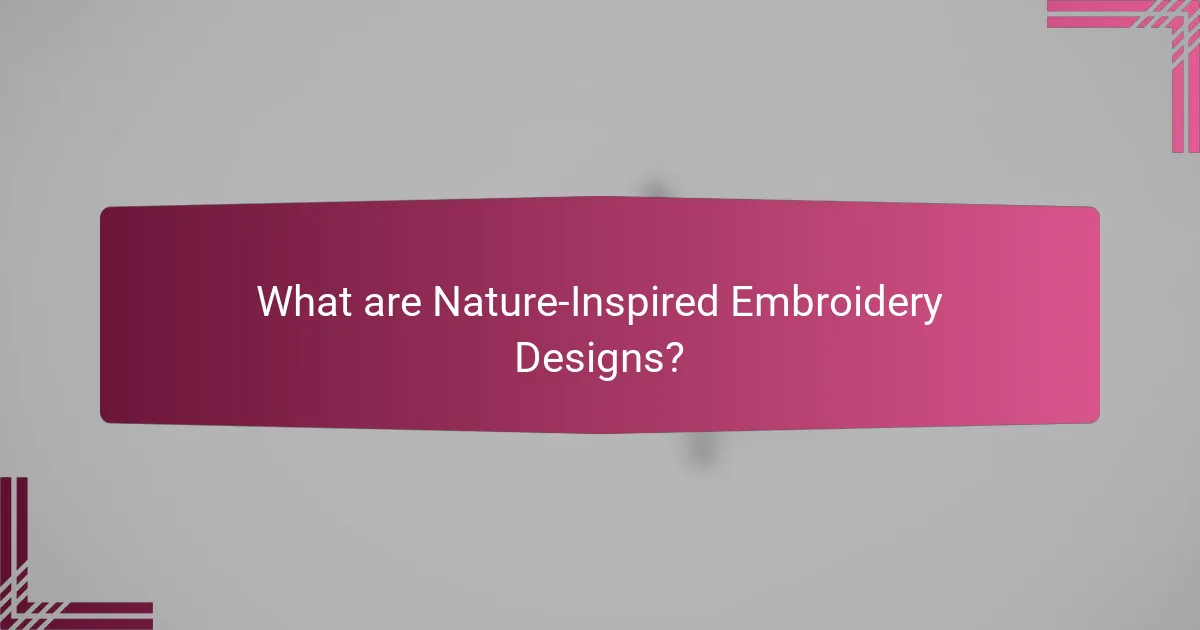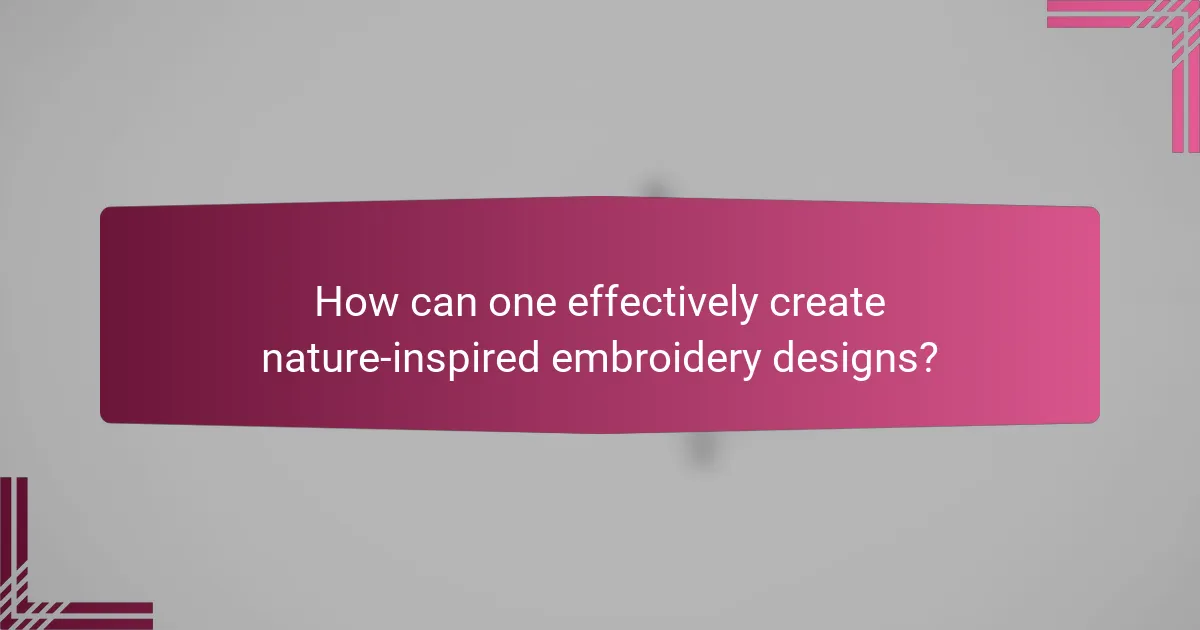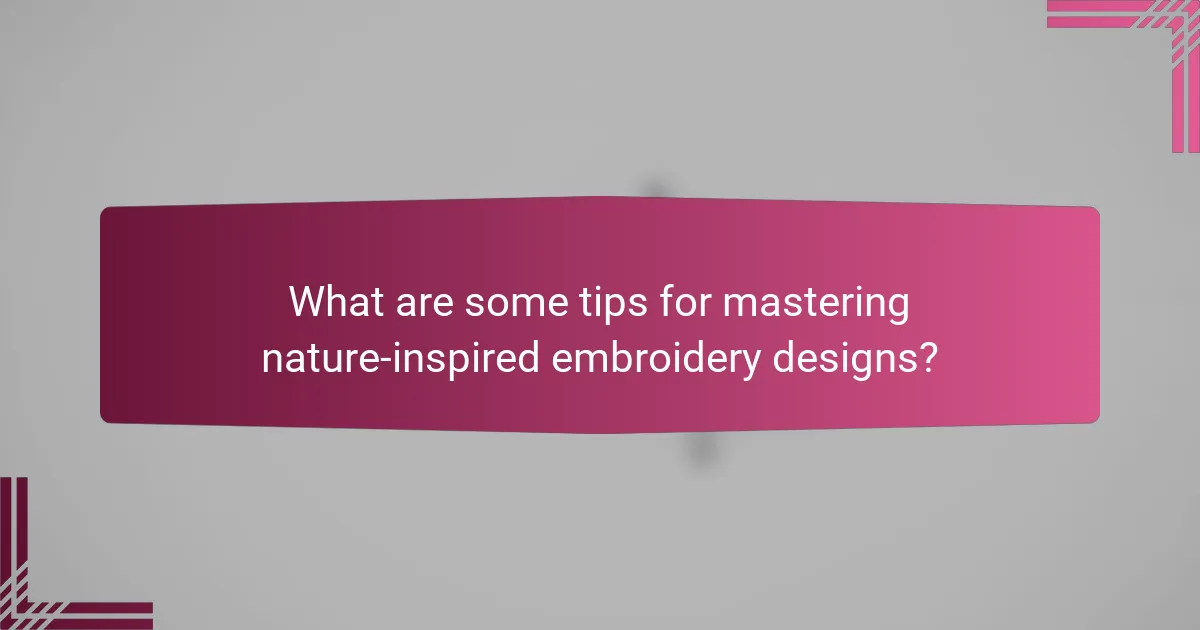
What are Nature-Inspired Embroidery Designs?
Nature-inspired embroidery designs are decorative patterns that draw inspiration from natural elements. These designs often feature motifs such as flowers, leaves, animals, and landscapes. The color choices typically reflect the hues found in nature, including greens, browns, and vibrant floral colors. Stitch techniques used in these designs can vary, incorporating traditional methods like satin stitch and French knots. The appeal of nature-inspired embroidery lies in its ability to connect art with the beauty of the natural world. This style is popular among crafters and artists for its versatility and aesthetic charm.
How do nature-inspired motifs influence embroidery design?
Nature-inspired motifs significantly influence embroidery design by providing thematic inspiration and visual elements. These motifs often include floral patterns, leaves, and animal shapes. They enhance the aesthetic appeal of embroidery, creating a connection to the natural world. Designers use these motifs to evoke emotions and convey messages related to nature. For instance, floral motifs can symbolize growth and beauty. The color palette in nature-inspired designs often mirrors natural hues, such as greens, browns, and blues. This alignment with nature can enhance the overall harmony of the design. Additionally, the use of organic shapes in motifs can lead to more fluid and dynamic compositions. Overall, nature-inspired motifs enrich embroidery by infusing it with deeper meaning and visual interest.
What are common examples of nature-inspired motifs?
Common examples of nature-inspired motifs include floral patterns, leaf designs, and animal representations. Floral patterns often feature roses, daisies, and sunflowers. Leaf designs can include ferns, maple leaves, and tropical foliage. Animal representations might showcase birds, butterflies, and fish. These motifs are prevalent in various art forms, including embroidery and textile design. They reflect the beauty and diversity of the natural world. Nature-inspired motifs are often used to evoke specific emotions and themes in artwork.
How do these motifs reflect natural elements?
Nature-inspired embroidery motifs reflect natural elements through their depiction of flora and fauna. These motifs often include flowers, leaves, and animals, mirroring the diversity found in nature. Colors chosen for these designs typically emulate the hues of natural landscapes. For instance, greens represent leaves, while blues can symbolize water. Stitch techniques also mimic natural textures, such as the smoothness of petals or the roughness of tree bark. This connection to nature enhances the visual appeal of the embroidery. Additionally, many motifs draw inspiration from specific ecosystems, showcasing unique plant and animal life. This approach creates a harmonious blend between art and the environment.
What role do color choices play in nature-inspired embroidery?
Color choices in nature-inspired embroidery are crucial for conveying themes and emotions. They reflect the colors found in natural elements like flowers, leaves, and landscapes. Vibrant colors can evoke feelings of joy and energy, while muted tones may suggest calmness and serenity. Specific color palettes can also symbolize different seasons, such as bright colors for spring and warm hues for autumn. Additionally, color choices help create visual harmony and balance in the design. Studies in color theory support that certain colors can influence perception and mood. Thus, careful selection of colors enhances the overall impact of nature-inspired embroidery.
Which colors are typically associated with nature-themed designs?
Colors typically associated with nature-themed designs include green, brown, blue, and earthy tones. Green represents foliage and plant life. Brown symbolizes soil and tree bark. Blue evokes water and sky. Earthy tones reflect natural landscapes. These colors create a calming and organic aesthetic. They are often used in various design contexts, including embroidery. Nature-themed designs aim to connect with the environment. The use of these colors enhances the theme of natural beauty.
How can color palettes enhance the overall aesthetic?
Color palettes enhance the overall aesthetic by creating visual harmony and emotional impact. They establish a cohesive look that can evoke specific feelings. For instance, warm colors like reds and oranges can convey energy and warmth. Cool colors such as blues and greens tend to evoke calmness and tranquility. The choice of colors can also influence the perception of space and depth. A well-chosen palette can make designs appear more vibrant and engaging. Studies show that color combinations can significantly affect viewer perception and mood. For example, a study by the Institute for Color Research found that people make judgments about an environment within 90 seconds based on color alone. Thus, effective color palettes are essential in enhancing the overall aesthetic of designs, including nature-inspired embroidery.
What stitch techniques are commonly used in nature-inspired embroidery?
Commonly used stitch techniques in nature-inspired embroidery include satin stitch, chain stitch, and French knots. Satin stitch is often utilized for filling areas, mimicking smooth surfaces like petals. Chain stitch creates flowing lines, resembling stems and vines. French knots add texture, simulating flower centers or seeds. Other techniques include back stitch for outlines and lazy daisy stitch for leaves and floral shapes. Each technique contributes to the organic feel of nature-inspired designs. These stitches allow for detailed representation of natural elements, enhancing the overall aesthetic of the embroidery.
What are the most popular stitch types for these designs?
The most popular stitch types for nature-inspired embroidery designs include satin stitch, backstitch, and French knots. Satin stitch creates smooth, filled areas, ideal for leaves and petals. Backstitch provides strong outlines, enhancing the definition of motifs. French knots add texture and dimension, perfect for floral centers. These stitches are favored for their versatility and ability to represent natural elements effectively. Their widespread use in embroidery projects is supported by their ability to create intricate and visually appealing designs.
How do different stitches affect the texture and appearance?
Different stitches significantly affect the texture and appearance of embroidery. Each stitch type creates a unique visual and tactile quality. For example, a satin stitch produces a smooth, shiny surface. This stitch fills shapes with a dense, glossy finish. In contrast, a backstitch offers a more defined outline with a textured feel. It creates a raised effect that enhances details.
Furthermore, a French knot adds dimension and a three-dimensional look. This stitch creates small, raised dots that provide visual interest. Similarly, a chain stitch produces a loopy texture that can be both decorative and functional.
Different stitches also influence the overall design by altering light reflection. Shiny stitches can draw attention, while matte stitches provide subtlety. The choice of stitch impacts the embroidery’s style, making it essential for achieving desired effects in nature-inspired designs.

How can one effectively create nature-inspired embroidery designs?
To effectively create nature-inspired embroidery designs, start by selecting natural elements as inspiration. Common motifs include flowers, leaves, and animals. Gather reference images from nature to guide your design process. Choose a color palette that reflects the natural world, using shades found in your references. Incorporate various stitch techniques to add texture and depth to your designs. For instance, use satin stitches for smooth areas and French knots for floral centers. Experiment with different fabrics to enhance the overall look. Finally, practice and refine your designs to achieve the desired effect.
What steps are involved in planning a nature-inspired embroidery project?
To plan a nature-inspired embroidery project, follow these steps. First, choose a nature theme, such as flowers or landscapes. Next, gather inspiration from nature through photographs or sketches. After that, select a color palette that reflects the chosen theme. Then, decide on the fabric type suitable for the project. Following this, choose the appropriate embroidery stitches that enhance the design. Finally, create a sketch or outline of the design to guide the embroidery process. Each step ensures a cohesive and visually appealing project that captures the essence of nature.
How do you choose the right motif for your project?
To choose the right motif for your project, first identify the theme and purpose of your embroidery. Consider the emotions or messages you want to convey through the design. Research various nature-inspired motifs that align with your theme, such as flowers, leaves, or animals. Evaluate the size and complexity of the motifs in relation to your project’s dimensions and skill level. Additionally, select colors that complement the motif and enhance the overall aesthetic. Review examples of similar projects for inspiration and guidance. This methodical approach ensures that the chosen motif resonates with your vision and project requirements.
What considerations should be made for color selection?
Color selection in nature-inspired embroidery designs requires careful consideration of harmony and contrast. Harmonious colors enhance the natural theme and create a cohesive look. Contrast can highlight specific motifs and add visual interest. Additionally, the emotional impact of colors should be considered, as different hues evoke various feelings. For example, greens and blues can convey tranquility, while reds and yellows may evoke energy. The context of the design also matters; colors should align with the intended setting or purpose. Lastly, the choice of thread material can affect color appearance, as different threads reflect light differently.
What tools and materials are essential for nature-inspired embroidery?
Essential tools and materials for nature-inspired embroidery include embroidery needles, embroidery floss, fabric, and hoops. Embroidery needles are necessary for stitching through fabric. Embroidery floss comes in various colors to represent natural elements. Fabric choices can include cotton, linen, or canvas, which are suitable for embroidery. Hoops help keep the fabric taut while working. Additional materials may include scissors for trimming threads and a water-soluble pen for marking designs. These items collectively facilitate the creation of intricate nature-themed designs.
Which fabrics work best for these designs?
Cotton and linen fabrics work best for nature-inspired embroidery designs. These materials provide a sturdy yet flexible base for intricate stitching. Cotton is breathable and easy to work with, making it ideal for detailed motifs. Linen has a natural texture that enhances the visual appeal of embroidery. Silk can also be used for a luxurious finish but may require more skill to handle. Additionally, canvas is suitable for heavier designs, providing durability. Each fabric type complements the organic themes typically found in nature-inspired embroidery.
What types of threads are recommended for nature-themed embroidery?
Cotton threads are recommended for nature-themed embroidery. They provide a soft finish and are available in a wide range of colors. Additionally, silk threads can add a luxurious sheen to designs. They are ideal for capturing the brightness of natural elements. Polyester threads offer durability and resistance to fading. They are suitable for outdoor-themed projects. Variegated threads create a gradient effect, enhancing the visual appeal of nature motifs. These threads mimic the subtle color changes found in nature. Finally, specialty threads like metallic or glow-in-the-dark can add unique accents to embroidery.

What are some tips for mastering nature-inspired embroidery designs?
To master nature-inspired embroidery designs, focus on selecting appropriate motifs. Choose elements like flowers, leaves, and animals that resonate with nature. Use a color palette inspired by natural landscapes. Earthy tones and vibrant floral colors can enhance your designs. Experiment with various stitch techniques to add texture. Techniques like satin stitch and French knots can bring your designs to life. Practice regularly to improve your skills and gain confidence. Studying nature closely can also inspire new ideas and techniques.
How can beginners improve their skills in nature-inspired embroidery?
Beginners can improve their skills in nature-inspired embroidery by practicing regularly and studying natural motifs. They should start with simple designs that reflect elements from nature, such as flowers or leaves. Utilizing a variety of stitches will enhance their technique. Beginners should also experiment with color palettes inspired by their surroundings. Joining embroidery groups or online communities can provide support and inspiration. Watching tutorial videos can help them learn new techniques. Finally, keeping a sketchbook of ideas can foster creativity and planning. These methods will lead to noticeable skill improvement over time.
What resources or tutorials are available for learning?
Online platforms offer a variety of resources and tutorials for learning nature-inspired embroidery designs. Websites like YouTube provide video tutorials demonstrating techniques and stitch methods. Crafting platforms such as Skillshare and Udemy offer structured courses on embroidery, often featuring nature motifs. Additionally, blogs dedicated to embroidery frequently publish step-by-step guides and pattern downloads. Books on embroidery techniques also serve as valuable resources, with many focusing on natural themes. Social media platforms like Instagram and Pinterest showcase tutorials and inspiration from various artists. These resources collectively support learners in enhancing their embroidery skills.
How can practice enhance your technique and creativity?
Practice enhances technique and creativity by allowing individuals to refine their skills over time. Regular practice leads to improved muscle memory, which increases proficiency in executing complex stitches. This proficiency enables artists to focus more on creativity rather than technique. As they become comfortable with their tools and materials, they can experiment with new motifs and color choices. Studies show that deliberate practice can lead to mastery in various artistic disciplines. For example, research by Ericsson et al. indicates that consistent practice significantly correlates with skill development. Therefore, practice is essential for both technical improvement and creative exploration in nature-inspired embroidery designs.
What are common challenges faced in nature-inspired embroidery, and how can they be overcome?
Common challenges in nature-inspired embroidery include color matching, design complexity, and material selection. Color matching can be difficult due to the variety of shades in nature. To overcome this, use color swatches or samples from nature to guide choices. Design complexity often leads to confusion during stitching. Simplifying the design into manageable sections can help. Material selection is critical; not all fabrics hold embroidery well. Choosing appropriate fabrics, like cotton or linen, can enhance the final result. Additionally, ensuring proper needle and thread compatibility is essential for achieving the desired look. Proper planning and practice can mitigate these challenges effectively.
What issues might arise during the stitching process?
Issues during the stitching process can include thread breakage, uneven tension, and fabric puckering. Thread breakage occurs due to improper threading or using the wrong type of thread. Uneven tension results from inconsistent pulling of the thread, leading to distorted stitches. Fabric puckering happens when the fabric is not properly stabilized, causing it to gather. Additionally, needle size can affect the stitching quality; using the wrong size may result in skipped stitches. Poor lighting can also hinder visibility, leading to mistakes. Finally, inadequate preparation of the design can lead to misalignment during stitching. Each of these issues can significantly impact the final outcome of the embroidery project.
How can you troubleshoot common problems in execution?
To troubleshoot common problems in execution, first identify the specific issue affecting the embroidery process. Common problems include thread breakage, uneven tension, and incorrect stitch placement. Check the thread quality and ensure it is suitable for the fabric type. Adjust the tension settings on the machine to achieve even stitches. Verify that the needle is appropriate for the thread and fabric. If the design is not aligning correctly, recheck the hooping technique and placement. Regular maintenance of the embroidery machine can prevent many issues. Keeping the workspace organized also minimizes errors during execution.
Nature-inspired embroidery designs are decorative patterns influenced by natural elements such as flowers, leaves, and animals, characterized by specific color choices and stitch techniques. This article explores the role of motifs in embroidery, common examples, and how they reflect natural elements. It also examines the significance of color palettes and stitch techniques, detailing their impact on texture and appearance. Additionally, the article provides guidance on creating effective designs, selecting suitable materials, and overcoming common challenges in the embroidery process.
